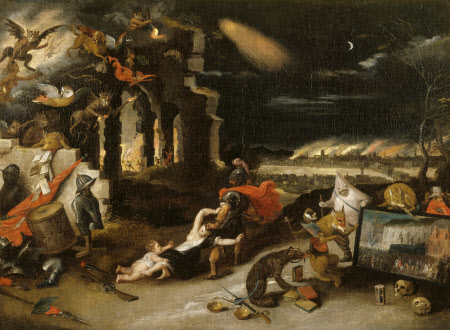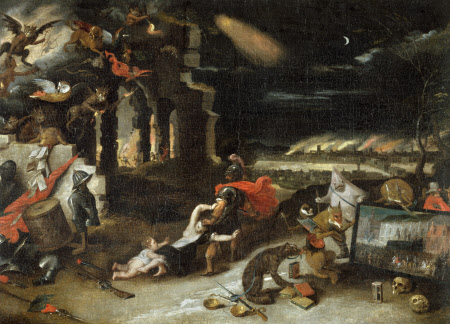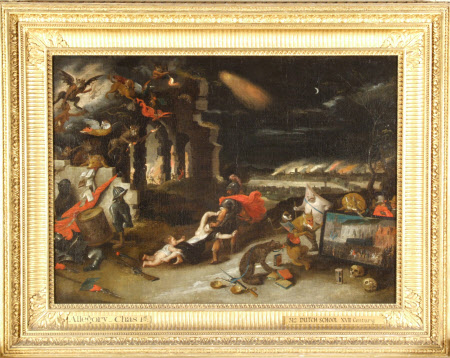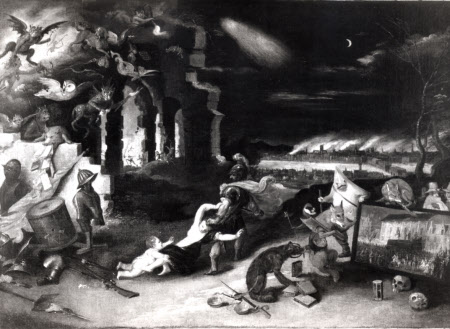Allegory on the Consequences of the Execution of King Charles I
after Jan Brueghel the Younger (Antwerp 1601 - Antwerp 1678)
Category
Art / Oil paintings
Date
1649 - 1699
Materials
Oil on canvas
Measurements
580 x 810 mm
Place of origin
Flanders (Belgium from 1830)
Order this imageCollection
Petworth House and Park, West Sussex
NT 486249
Caption
The symbolism of the present picture suggests the dire events that are the outcome of Charles I’s execution. The centre of interest is the picture of the martyrdom of Charles I, with the Banqueting Hall, inaccurately portrayed, in the background. This derives from a representation found in a number of Netherlandish and German propagandistic prints and broadsheets. The executioner, a masked fox, with an axe and iron cooking pot (possibly a reference to Cromwell’s “Ironsides”), is regarding the scene, and beside him sits a slavering hound – Fairfax sometimes appeared in Dutch prints as Cromwell’s hound, “the bloodhound Fairfax”. The books scattered around the animal are the works of Luther, Calvin, Machiavelli, and the Laws of England. The evils unleashed by the Execution fill the remainder of the composition: an Antique warrior drags a mother by her hair, representing the brutality of war; and in the background, London is shown in flames.
Summary
Oil painting on canvas, Allegory on the Consequences of the Execution of King Charles I by after Jan Brueghel the younger (Antwerp 1601 – Antwerp 1678). A seventeenth-century allegorical painting of the martyrdom of Charles I. In the distance, London is burning, and in the background are demons and a burning building. In the centre foreground War is dragging a woman by her hair, whilst at right, a wolf and a fox with books which are inscribed 'Luter', 'Calvin' 'Marcialis', and a pair of scales, skulls and a picture of Charles Ist's execution. On a wall at left a pig vomits documents, one inscribed 'Judici Inlegi', another 'Falsi'.
Provenance
In the collection of the 3rd Earl of Egremont (1751-1837) by 1835; thence by descent, until the death in 1952 of the 3rd Lord Leconfield, who had given Petworth to the National Trust in 1947, and whose nephew and heir, John Wyndham, 6th Lord Leconfield and 1st Lord Egremont (1920-72) arranged for the acceptance of the major portion of the collections at Petworth in lieu of death duties (the first ever such arrangement) in 1956 by HM Treasury.
Credit line
Petworth House, The Egremont Collection (National Trust)
Makers and roles
after Jan Brueghel the Younger (Antwerp 1601 - Antwerp 1678) , artist




